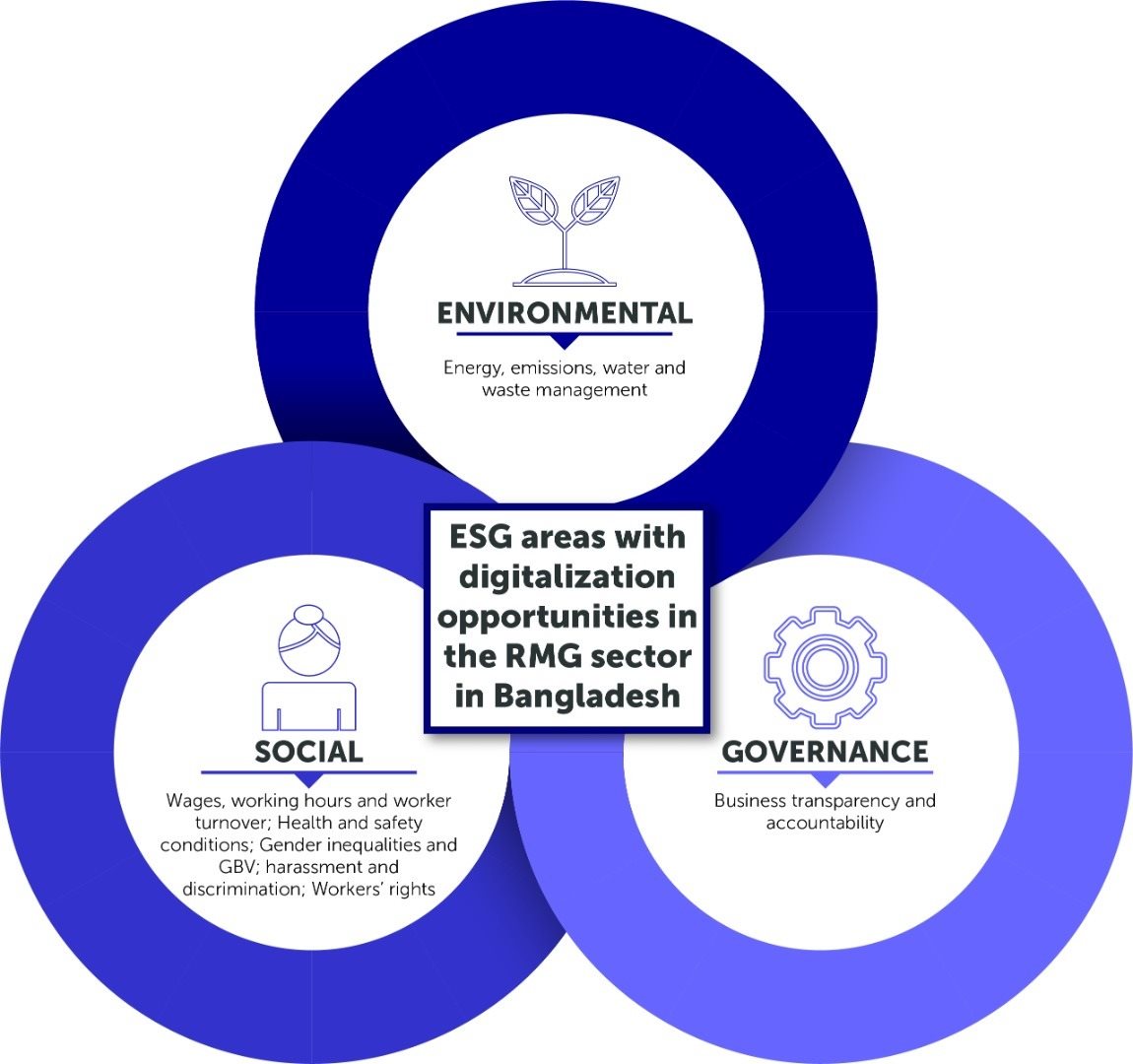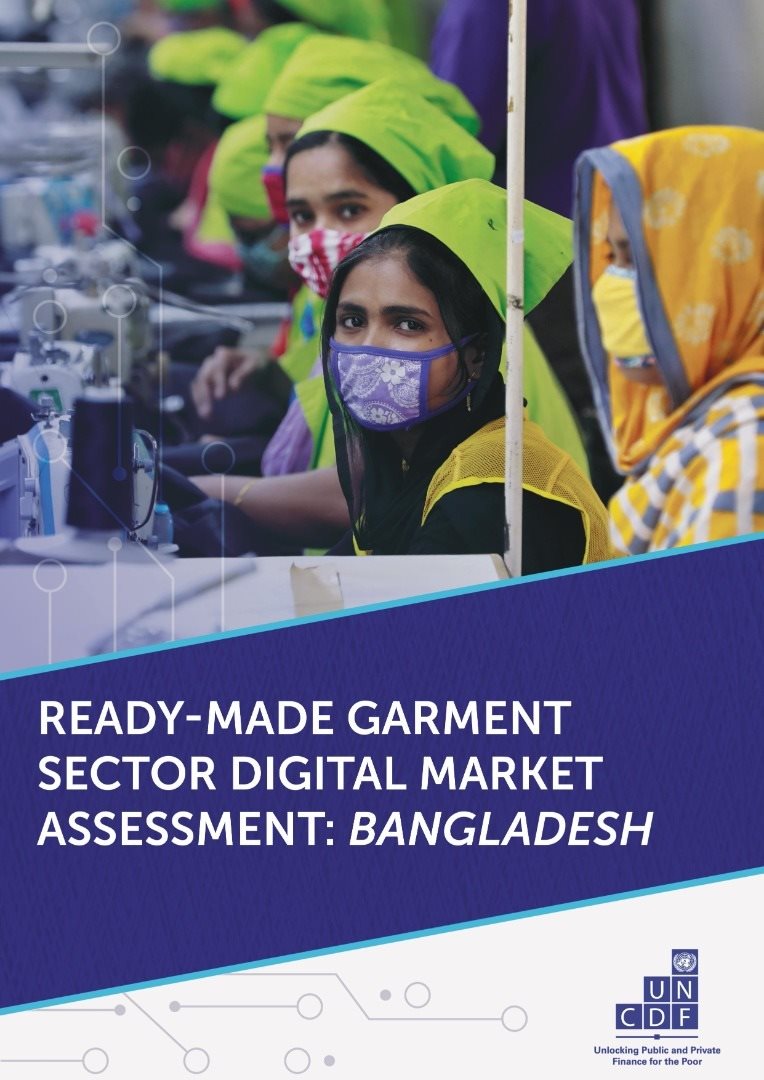The ready-made garment (RMG) sector that employs an estimated 4.2 million people, of whom 2.5 million are women, is a cornerstone of Bangladesh’s export prowess and overall economic growth. There are opportunities to improve Environmental, Social and Governance (ESG) sustainability aspects to strengthen the sector’s competitiveness and potential for further investment.
A new UNCDF report Ready-Made Garment Sector Digital Market Assessment: Bangladesh details opportunities across ESG sustainability aspects to improve the decency of work and livelihoods of millions of people employed in the RMG sector in Bangladesh.

The ongoing COVID-19 pandemic coupled with trends towards automation and Industry 4.0 are making these ESG opportunities more challenging to achieve and are negatively affecting jobs and livelihoods of people employed in the sector. Digital services offer a solution to improve sustainability aspects across the ESG spectrum, enhancing RMG industry competitiveness and growth and livelihoods for workers. There have already been great strides in increasing usage of digital financial services among RMG employees through digitization of wages in recent years. The COVID-19 pandemic has accelerated the push of wage digitization with proven employer and employee benefits.
According to the Better Than Cash Alliance, the current level of wage digitization in the RMG sector in Bangladesh stands at 54 percent, having fallen from its peak of 90 percent at the onset of the COVID-19 pandemic as a result of a sudden increase in conjunction with the stimulus package during 2020 that was mandated to be paid to employees via digital means. Challenges for making wage digitization general practice remain including the high cost of money transfer, the lack of an interoperable digital payment ecosystem, and low digital and financial literacy of digital financial service users leading to missed opportunities.
How can digitalization improve the livelihoods of RMG employees?
From the RMG employee perspective, a major barrier impeding the potential benefits of digitalization in the sector is low ownership of, and access to, smartphones. According to the digital market assessment 59.3 percent of female RMG employees and 31.3 percent of male RMG employees do not use smartphones. Of the female RMG employees who do use smartphones, 39.3 percent do not own them but rather use smartphones owned by their partners or family members. Regarding Internet connectivity, male RMG employees (77.1 percent) have better access than their female counterparts (44 percent). Overall, RMG employees desire lower Internet costs and reported that their usage of digital services would increase with lower Internet data costs.
Stakeholders strongly advocate for a more integrated digital payment ecosystem and deemed it a prerequisite for RMG employees to be using mobile and digital financial services more efficiently. Digitalization of different payment use-cases for house rent, payment of groceries and school fees, can take place to achieve a larger ecosystem. Opportunities for digital financial services exist in, for example, introducing savings products and long-term savings and pension products, independent of the employer, and introducing shariah-based banking products for RMG employees. RMG employees are interested in long-term saving products and facilities for digital pensions if they can take their savings with them in case of switching employer and intrigued that they might be able to track their pension funds in real time.
Awareness of digital healthcare services among RMG employees


Opportunities in terms of digital health services include monthly subscription-based or insurance products financially supported wholly or partially by the employer, among others. While the majority of RMG employees are aware of such services, 99 percent do not use them. Collaborations between HealthTech and financial service providers could create new business opportunities. For example, through integrating digital health services and digital health insurance offerings.
Desired skills/education topics for RMG employees

EdTech services could provide reskilling and upskilling opportunities and close the gender skill gap existing in the sector. Generally, RMG employees are aware about IR 4.0 trends and almost half of those that are aware are worried about their job security in light of them. Overall, 66 percent of female and 81 percent of male RMG employees are interested in learning new skills related to their jobs. It will be crucial to make EdTech platforms and Internet connectivity available and affordable to RMG employees to use these tools. Telecom providers could introduce bundles for certain services targeted towards RMG employees to increase usage.
What are the benefits of digitalization for RMG manufactures?
From the RMG manufacturer perspective, the manufacturers have taken various initiatives to orient and educate employees on the use of digital financial services as part of their wage digitization initiatives. Additionally, the assessment reviewed the opportunities of digitalization from an enterprise perspective to increase overall sustainability of the sector and therefore its competitiveness and possibility to attract further investment. This includes, for example, implementation of high-integrity, low-cost systems to manage, and disclose, sustainability data across the ESG spectrum and the SDGs. Such digital systems will enhance transparency and allow manufacturers to actively track and seek ways to improve their own sustainability.
Digitized tracking of sustainability at enterprise level can open up opportunities of providing high-integrity, low-cost and verified data on sustainability performance with possible applications ranging from public disclosure to increase trust and strengthen competitive advantage to use in tracking sustainability performance targets for sustainability-linked finance instruments and application in credit assessments.
Having more integrated and organized sustainability data management systems could aid in integration of ESG sustainability metrics in credit ratings and development of more sustainability-linked financing options for manufacturers to increase the sector’s sustainability. More high-integrity and low-cost sustainability data management systems need to be developed and offered to make them more attractive for manufacturers and credit-providing financial institutions. As a case in point, there are two examples of the first sustainability-linked loans in Bangladesh implemented during 20201 linking environmental sustainability performance targets to the interest rate of the loan, specifically the use of clean energy.
There is potential for implementing similar types of financial instruments as incentives to improve in other areas of sustainability performance, also using targets on social sustainability indicators or overall sustainability ratings. The cost of capital could, for example, be linked to progress on a particular social sustainability performance indicator. This is contingent on the availability of low-cost, high-integrity data available on social sustainability performance at the manufacturer level, which the credit-providing financial institution or investor can use to track the manufacturer’s progress.
Going forward
This research is part of the Promoting Digital Ecosystem Solutions Addressing Women Livelihoods through Ready-Made-Garment Sector Sustainability amidst COVID-19 and Beyond project, launched by UNCDF in May 2021. As the next step in the project UNCDF is launching a Request for Applications to provide performance-based grants to two winning applicants to support implementation of new business models that drive inclusive digitalization for RMG manufacturers and their employees, capitalizing on the opportunities to improve livelihoods and the sector’s overall sustainability. For more information about the Request for Applications please click here.



